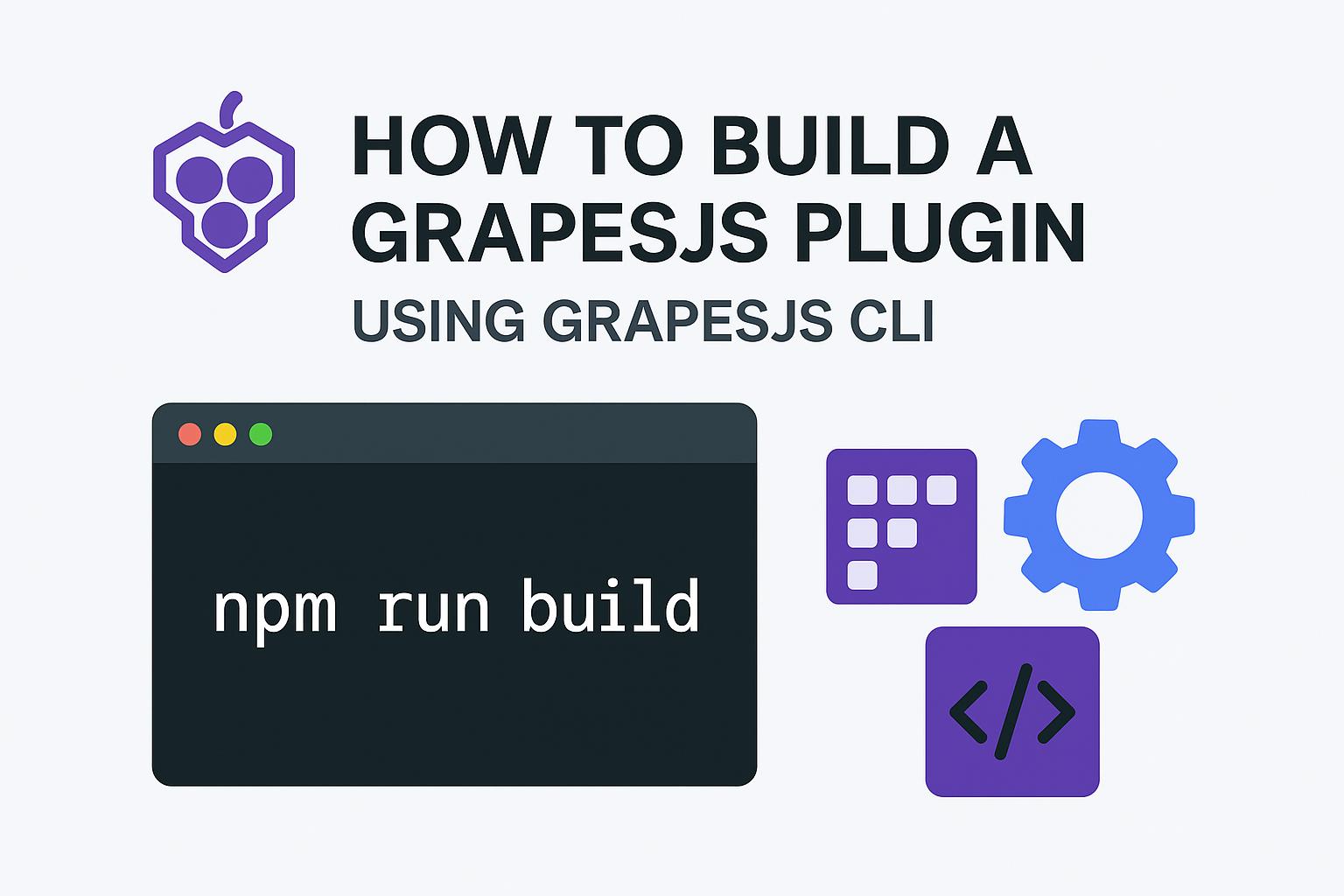Introduction
GrapesJS is one of the most flexible open-source frameworks for creating drag-and-drop web builders. Its true power lies in its plugin ecosystem, which allows developers to extend the editor with new blocks, traits, panels, commands, and integrations.
This article provides a complete, step-by-step guide on how to build a GrapesJS plugin from scratch using the official GrapesJS CLI. It is designed for developers, agencies, and companies looking to create custom solutions or contribute to the growing GrapesJS community.
Key takeaways from this guide:
- What GrapesJS and GrapesJS CLI are
- How to scaffold a new plugin project with CLI
- Writing the first plugin logic (blocks, traits, commands)
- Running a dev server and building production-ready code
- Monetization opportunities
What is GrapesJS?
GrapesJS is an open-source, MIT-licensed web builder framework developed in 2016. It is widely used for:
- Website builders
- Email template editors
- Page and document design tools
- Drag-and-drop interfaces in SaaS products
Core features:
- Drag-and-drop block manager
- Custom traits and style system
- Device preview modes (desktop, tablet, mobile)
- Layer manager and style panel
- Fully extensible plugin system
👉 Plugins are essential because they allow developers to build specialized features without bloating the GrapesJS core.
What is GrapesJS CLI?
The GrapesJS CLI is the official command-line interface for plugin development. It eliminates the complexity of setting up build systems by providing:
- Scaffolding → Generate a ready-to-use plugin project with one command
- Development server → Run and test the plugin live inside GrapesJS
- Production build → Output minified, optimized code for distribution
In short, GrapesJS CLI provides everything required to start developing plugins immediately.
Step 1: Initialize a Plugin with GrapesJS CLI
To create a plugin named grapesjs-my-plugin:
Create a new folder:
mkdir grapesjs-my-plugin cd grapesjs-my-plugin
Initialize npm:
npm init -y
Install the CLI:
npm install --save-dev grapesjs-cli
Scaffold the plugin project:
npx grapesjs-cli init
This generates a full project structure with an entry file at src/index.js.
Run the development server:
npx grapesjs-cli serve
The plugin will load inside GrapesJS at http://localhost:8080.
Build for production:
npx grapesjs-cli build
The compiled plugin will be available in the dist/ folder.
Step 2: Project Structure
A scaffolded GrapesJS CLI project includes:
grapesjs-my-plugin/
├── src/ │ └── index.js ← main plugin entry file ├── dist/ ← compiled distribution files ├── package.json ├── README.md ├── babel.config.js ├── webpack.config.js ← optional custom config
- src/index.js → contains the plugin logic
- dist/ → production-ready build output
- README.md → documentation template
- webpack.config.js → allows customization of the default build configuration
Step 3: Writing Plugin Logic
In src/index.js, add plugin features.
Example: Adding a block
export default (editor, opts = {}) => {
const bm = editor.BlockManager;
bm.add('hello-block', {
label: 'Hello Block',
category: 'Basic',
content: '<div class="hello-block">Hello from the plugin!</div>',
});
};
Example: Adding a custom trait
editor.TraitManager.addType('uppercase', {
createInput() {
const el = document.createElement('input');
el.type = 'checkbox';
return el;
},
onUpdate({ elInput, component }) {
const checked = elInput.checked;
component.addStyle({ 'text-transform': checked ? 'uppercase' : 'none' });
}
});
Example: Adding a command and panel button
editor.Commands.add('say-hello', {
run(editor) {
alert('Hello from GrapesJS plugin!');
}
});
editor.Panels.addButton('options', {
id: 'say-hello-btn',
className: 'fa fa-bell',
command: 'say-hello',
attributes: { title: 'Say Hello' },
persist: true,
});
Step 4: Running and Debugging
When using npx grapesjs-cli serve:
- Monitor events with editor.on('event-name', callback)
- Inspect selected components with editor.getSelected()
- Test traits and style updates directly in the live editor
Step 5: Building and Publishing
Create a production build:
npx grapesjs-cli build
Complete the README.md with:
- Plugin description
- Configuration options (opts)
- Example usage snippets
- Demo link
Publish to npm:
npm publish
Share on:
- GJS.Market
- GitHub repository
- Open-source developer communities
Step 6: SEO & Distribution Strategy
Recommended actions:
- Publish technical blog posts with usage examples
- Write tutorials on Dev.to, Medium, Hashnode
- Record video walkthroughs on YouTube
- Submit to Reddit r/webdev and Hacker News
- Create backlinks from related open-source projects
Step 7: Monetization Opportunities
Companies and developers can:
- Release a Pro version with advanced features
- Provide custom integrations for SaaS and agencies
- Sell plugins on GJS.Market
- Offer paid support, maintenance, or consulting
Key Takeaways
- GrapesJS is a powerful framework, but plugins make it truly flexible.
- GrapesJS CLI provides an easy way to scaffold, serve, and build plugins.
- Start with simple blocks or traits, then expand functionality.
- Documentation and SEO are critical for plugin adoption.
- Monetization options exist for commercial use cases.
Conclusion
With the GrapesJS CLI, building plugins becomes a streamlined process: scaffold the project, add logic, run a live server, and build production-ready files.
Plugins not only extend GrapesJS but also open opportunities for businesses to innovate, grow visibility, and generate revenue.
👉 Run:
npx grapesjs-cli init
to start building your own GrapesJS plugin today.
